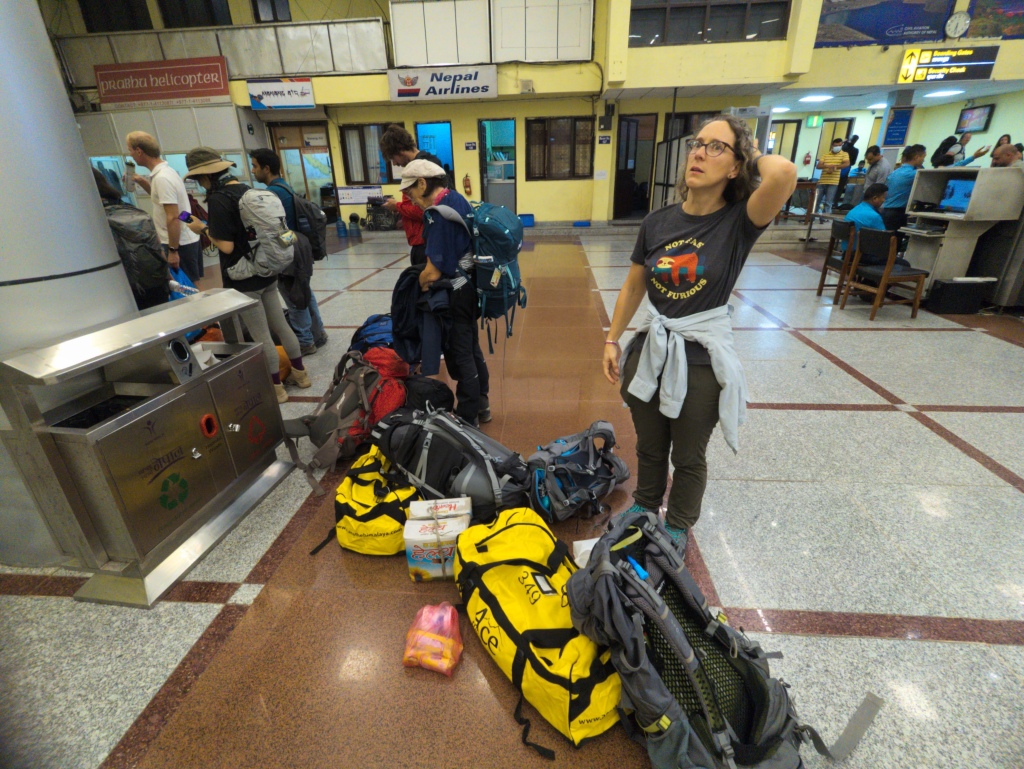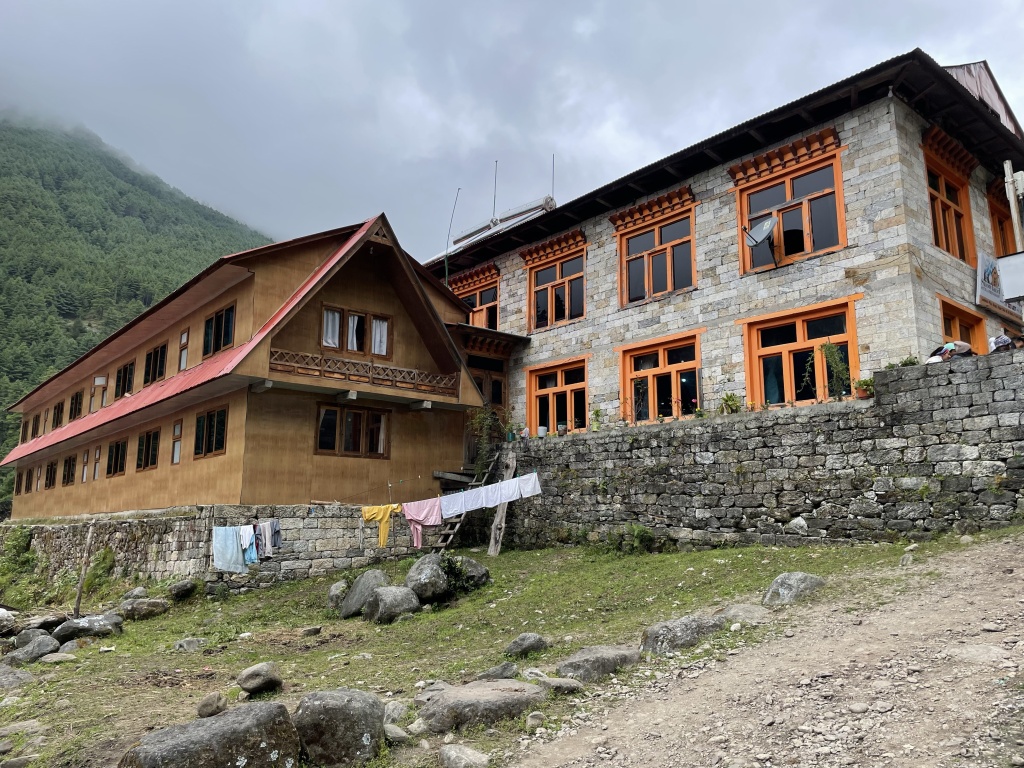Here’s the best and most reliable tip I’ll have to offer for this whole adventure: hire a guide. If you hire a good guide, you can stand back and watch the guideless-tourists struggle to communicate and figure out all the red tape while your guide jumps to the front of the line and just makes everything happen, as if by magic.
Allow me to introduce you to Lama Surya, trekking guide, awesome human, and my current favorite person in the world:

Surya has been with our tour company, Ace the Himalayas, for seven years. He started as a porter and worked his way up to lead guide. He has trekked to Everest Base Camp more than 100 times. He speaks Nepali, Hindi, Arabic, English, and the local Gurka dialect of his home region.
On the morning of our first hike, Surya collected us and our very-carefully-weighed bags from the hotel at 6am. Absolute max luggage per person is 15 kilos (33 pounds). The airplane is barely bigger than a model you could build on your kitchen table; they will leave your bags behind if they’re too heavy. Meeting the limit wasn’t difficult, using the packing list the company provided, even with all of Dustin’s camera equipment. When we clocked in at a solid two pounds under, we patted ourselves on the back and both added an extra pair of socks and underwear.

Within ten minutes of arriving at the airport, we had passed through security and reached the gate, where we stood around while Surya managed our passports and got us checked in. I watched a handful of other foreigners try to fend for themselves and felt my first wave of extreme-guide-gratitude for the day.

A few minutes later, we got herded onto a shuttle bus with a couple dozen other people and driven out to the small-planes end of the runway to await our flight, run by Sita Air. (I was disappointed not to be on a Yeti Air flight, but what can you do?)

The plane only seated 15 people. “Get a seat on the left side!” Surya whispered as they opened the door to start boarding. (Yay inside tips!)
I snagged the last seat on the left, with poor Dustin stuck across the aisle from me. The attendant passed out cotton balls for us to stick in our ears and I examined the safety card, which showed me where to find the first aid kit and the ax.
The flight was short, non-pressurized, and very, very loud. I got my first glimpse of some Himalayas out my window, though my efforts to photograph them were dismal.

Toward the end of the flight, the mountains around us towered well above our flight altitude. The runway – built basically into the side of a cliff – simply appeared under us one moment. It was quite unnerving.
Lukla airport is considered the most dangerous airport in the world, because of the length of the runway (1,729 feet) and that drop-off at the end. It slopes upward into the mountainside to help planes stop in time, or to help them take off in time.

The. Whole. Runway.
And, of course, we landed just fine, as everyone always does. I think the airport should more accurately be dubbed the Scariest Airport in the World, since “dangerous” implies accidents happen often, which they don’t.

We stopped for a quick, recuperative cup of tea, then reorganized our bags and headed down the hill to get our permits.

To trek in this part of the Himalayas, you need a permit from the Nepali government. The area approaching Everest is designated as Sagarmatha National Park. Sagarmatha is the Sherpa name for Everest.
A half-mile walk from the airport brought us to the permitting station where we, again, sat back and enjoyed the mountain vistas while Surya arranged the permits.
And then we began for real.
Here are the day-one hike stats:
- Starting location: Lukla, 2,840m (9,344 feet)
- Max elevation: 2,840m (9,344 feet)
- Min elevation: 2,548m (8,356 feet)
- Ending location: Phakding village, 2,610m (8,601 feet)
- Elevation change: 227m (743 feet) lost
- Distance traveled: 5.1 miles in 3 active hours, 4:50 total
- Average pace: 33’14” per mileage
Day One is a gentle intro to Himalayan hiking. By “gentle,” I mean no really nasty elevation changes, and your net result is slightly downhill from where you started. The trails are wide but very rocky, and you are sharing them with a million other hikers, their guides, porters, yaks, and donkeys.


The scenery is incredibly beautiful. I hadn’t expected a Himalayan hike to be so green, even in the beginning, but the tree line is about 4,000 feet higher here than it is at home, so for at least the first four days we’ll be in and out of forests.

Today’s trek was along areas surprisingly well-populated, with tiny villages and little houses all along the way. I am enamored with the vegetable gardens growing all over. No tidy rows here, only patches of random cabbages, fields of leafy greens growing like grass, trees of vining beans propped up on crooked sticks. We’ve been advised to eat as vegetarians while on this trip, and you can see why it’s a good idea.

Nepali guides estimate hiking in hours, not distance. I find this method highly suspect. They cannot possibly understand how slow I am. Today’s hike was estimated at 3-4 hours, so I made my best guess that we’d likely be doing 6 miles. Half an hour per mile is a fairly middle-of-the-road estimate.
When we pulled over at our guest house just past the 5-mile point, I felt both pleased and a little cheated. I could have done more! (This will become a theme on this trek. They never ask you to do as much as you can do, because if you do that too many days in a row, you start being able to do less and less every day. They’re smart cookies.)

Guests houses offer rooms or varying privacy (from “single” to “shared with 10 of your closest friends you made just now”). Dustin and I will have private, two-bed rooms for the whole trek, with the bathroom down the hall with maybe one or two exceptions.
We did some exploring of Phakding after lunch. It’s not big, but very picturesque. Evidence of the (mainly) Buddhist cultural influence in the region is visible everywhere.

I’ve taken a particular liking to the prayer wheels that can be found in the vicinity of many stupas (shrines) and free-standing through the villages we’ve passed.

Tomorrow, we start going up.